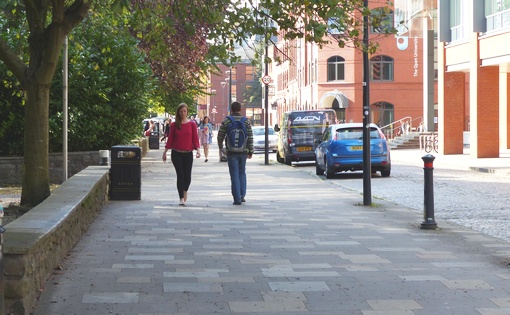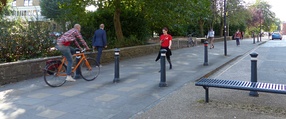
Walking Improvements
Improving walking infrastructure will encourage more people to walk around the city.
Walking provides a big health benefit to people who would normally use their cars, or people who wouldn’t go out at all. Walking is a very accessible way to exercise, and can be part of everyday life, when going to work or shopping.

Healthier people
People who walk regularly live considerably longer than people who do no physical activity.
This is because regular walking reduces the risk of contracting multiple diseases and conditions, such as coronary heart disease, stroke and some cancers.
Any exercise, including walking, improves mental wellbeing, and helps to maintain a healthy body weight.
Further Benefits
These benefits from walking can easily be enjoyed by the majority of people, and walking can easily be integrated into everyday life when travelling around the city. It's available to all ages, and at any time of the year.
There are benefits for the city of Bristol too, which will experience less air pollution and congestion if people switch from using their cars to walking around the city instead.
Advanced information
The statement that people who walk regularly live considerably longer than people who do no physical activity is based on a study from Moore et al. (2012). The study combined data from six individual pieces of research, comprising of more than 650,000 participants, of which 82,000 died during the study period. Compared to no leisure time physical activity, low levels of moderate to vigorous physical activity resulted in life expectancies being higher by 1.8 years. Levels at or just above that recommended by guidelines, of a minimum of 150 minutes of at least moderate physical activity each week, were associated with even lower risks of premature death and higher life expectancies (3.4 years higher). Finally, levels at two and three or more times the minimum recommended level were associated with further, albeit diminishing, reductions in risk of premature death. Life expectancies were higher by 4.2 and 4.5 years for those participating in such levels of physical activity per week. A key means of gaining leisure time physical activity in this large participant study was through walking.
A study from Morris and Hardman (1997) identified the links between regular walking and reducing the risk of contracting multiple diseases, maintaining mental wellbeing, and reducing the risk of developing some forms of cancer. Based on a literature review of multiple sources of evidence from two leading authors in the field of activity and health, this paper is a good source of evidence.
A statement from the chief medical officer (department of health) identified that “the easiest and most acceptable forms of physical activity are those that can be incorporated into everyday life”. Walking was the first example of such an activity.
References
Moore, S., Patel, A., Matthews, C., Berrington de Gonzalez, A., Park, Y., Katki, H., Linet, M., Weiderpass, E., Visvanthan, K., Helzlsouer, K., Thun, M., Gapstur, S., Hartge, P., Lee, I. (2012) Leisure Time Physical Activity of Moderate to Vigorous Intensity and Mortality: A Large Pooled Cohort Analysis. PLOS Medicine, 9:11 e1001335
Morris, J. & Hardman, A. (1997) Walking to health Sports Medicine, 23 (5): 306-332
Department of Health (2004) At least five a week. Evidence on the impact of physical activity and its relationship to health. A report from the Chief Medical Officer. London: Dept. Health.






